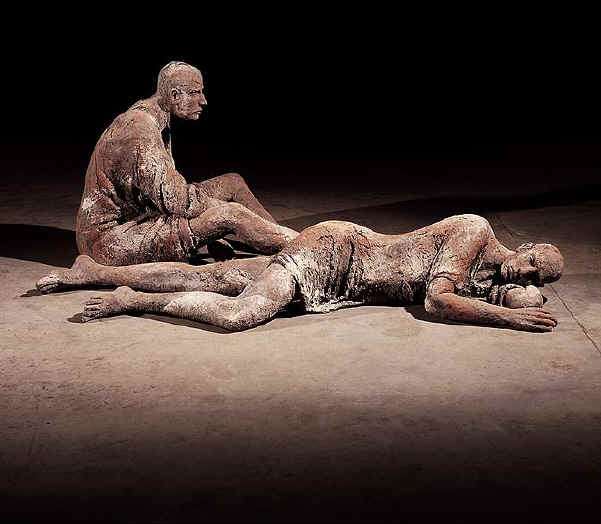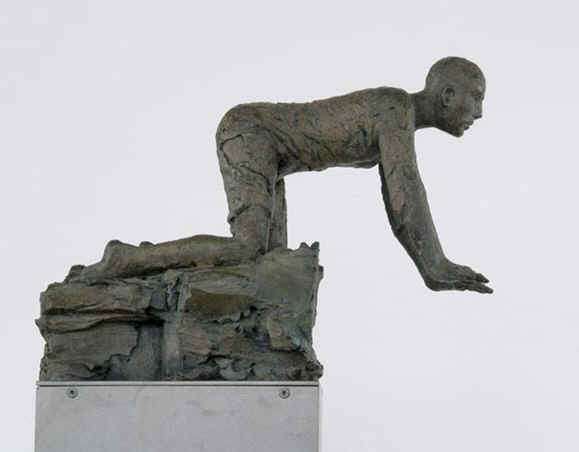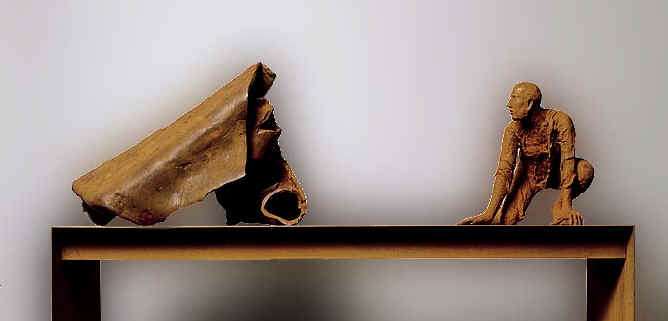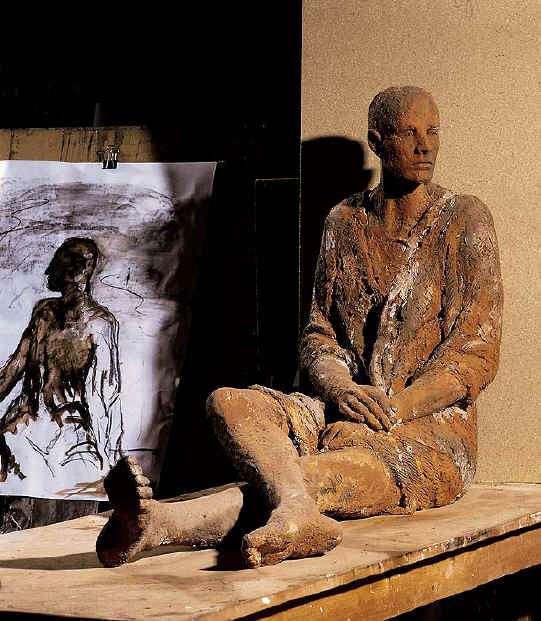
december 2004
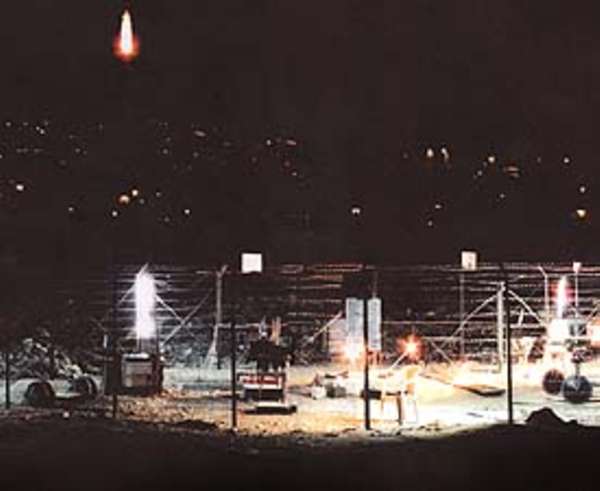
Abillama returns with sculptures that act
Lebanese artist's angular creations sculpted in metal provoke puzzlement, wariness, and a mild sensation of terror
By Kaelen Wilson-Goldie ŠAll Rights Reserved
Daily Star staff
Tuesday, November 09, 2004
BEIRUT: Writing about the American sculptor Lee Bontecou and her ability to create three-dimensional objects that were neither paintings nor sculptures, art critic-turned-minimalist pioneer Donald Judd once said: "The image cannot be contemplated; it has to be dealt with as an object, at least viewed with puzzlement and wariness, as would be any strange object, and at most seen with terror, as would be a beached mine or a well hidden in the grass. The image extends from something as social as war to something as private as sex, making one an aspect of the other."
The 11 objects on view in Ziad Abillama's exhibition "Delire Esthetique (Aesthetic Delirium)," on view at Galerie Epreuve d'Artiste in Saifi Village through Nov. 13, bear no real physical resemblance to Bontecou's strange creations culled from salvaged metal and cloth. Yet like Bontecou's work, Abillama's angular pieces sculpted in cut, bent and curved metal provoke puzzlement, wariness and a mild sensation of terror (one of his works has razor-sharp teeth and many of them look like war machines or tools in a torture chamber). And like Bontecou and her contemporary Eva Hesse, Abillama somehow cuts to core of contemporary art's most pressing and longstanding questions: What should art be and what can art do and how can it create meaning? What can you read in - and into - these works? What do you want from them and, perhaps more unsettling, what do they want from you?
Because Abillama is making art some 40 years after Bontecou and Hesse, his work can be adequately billed as sculpture without the baggage of parsing out art historical genres and terms. But his exhibition here is distinctly about art as object, as opposed to art as installation or intervention. As such, "Delire Esthetique" is a study in contrasts - literally, as nine out of 11 works are dunked in glossy black and white paint, and figuratively, when you consider what Abillama was producing before.
As a kid growing up in Lebanon in the 1970's, Abillama was what you'd call a jock. The three-time judo champion also proved himself an expert draughtsman, and he and his family agreed he'd pursue a proper job that utilized his drawings skills and do artwork as a hobby to fill idle time. Abillama went to Amherst College in Massachusetts, where he studied physics for two years.
"Physics is wonderful and amazing and wants to understand everything," he recalls. But by his third year, he switched to art and took a semester off Amherst to do studio work at the Rhode Island School of Design (RISD).
When asked when and where he was born, Abillama answers obliquely. "I was born during the Gulf war," he says. "I had no identity before that."
During that much-televised conflict, he remembers, "I discovered that I was going to be an Arab no matter what. I had to do a lot of homework," he adds, which involved reading everything from Michel Foucault to Edward Said. These studies "enabled me to understand there was a confrontation. I was born when I became fascinated yet never completely overcome by the political."
Abillama realized that politics could never be entirely divorced from religion or culture and that they were all wound up in the same inextricable (and sometimes combustible) nugget. This idea may be coming into its own in Abillama's new work, but it manifested itself differently at first.
By the summer of 1992, Abillama was back in Lebanon after the country's civil war had come to a rather enforced end. In August of that year, he carved out a site-specific installation on a patch of beach lying along the coast north of Beirut. Known variously as the Saint-Free or General's Beach (after ousted former general Michel Aoun), the plot of land had become a dumping ground. Abillama cleared the trash from a small area and erected a circular enclosure of steel poles and barbed wire. Inside, he placed a collection of strange and sinister sculptural objects made like bricolage from scrap metal, discarded weapons and military gear.
This installation, best documented in fellow artist and writer Walid Sadek's essay "From Excavation to Dispersion: Configurations of Installation Art in Postwar Lebanon," is widely pegged as the first of its kind. "There is in this work," writes Sadek, "a sufficient condensation of ideas and methodological hybridization for it to be considered a crucial event and a violent restart of the arts in the postwar period."
That violent restart triggered the kind of critical art practices that have now reached international acclaim. To accompany the beach piece, Abillama made a poster called "Wherearethearabs?" featuring derogatory quotes about Arab civilization alongside texts celebrating modernity and speed. On the invitation card, he placed fey statements praising his own talent and ingenuity.
Taken as a whole, Abillama's installation tossed up a tangled cluster of complex questions: What was found and what was fabricated? What was the meaning of these terrifying, jerry-rigged war machines? Why were they enclosed? Who was allowed into this barbed-wire camp and who was kept out? Why was anyone or anything on this particular beach anyway? What was the relationship between object, image, and text? What was Abillama trying to say about war, violence, memory, nostalgia, waste, consumption, discourse, truth, parody or critique? How much can contemporary art actually do in terms of stirring debate or stimulating change? Is art ever a catalyst for anything more than a reciprocal celebration of its own cleverness?
Most of these questions are still up for discussion. But there was one thing this installation and subsequent others did accomplish: They opened up a real and theoretical path into a real and theoretical junkyard. As Sadek has suggested, they created entry points back into the city. They made possible the practice of making art that was critically engaged and fully aware of its own urgency and anxiety at a time when public discourse fumbled badly in the wake of collective trauma.
Abillama continued to work in this vein through the mid- 1990's. But in terms of one artist's work to another's, Abillama is no longer in dialogue with his contemporaries (such as Sadek, Bilal Khbeiz, Tony Chakar, et al). As his colleagues have pressed on with bigger, bolder and more ambitious installations and interventions - negotiating the ills of overexposure and the temptations of the marketplace along the way - Abillama has largely fallen off that scene.
In 1999, he mounted a comeback with an exhibition of 20 sculptures at Epreuve d'Artiste, back when it was still housed on Sursock Street in Achrafieh. The works in that show were all grand-scale metal sculptures in exuberant colors, warm curves and rounded openings fusing organic and geometric forms. They were joyous and majestic yet concrete, contained and decidedly retrograde. For anyone familiar with Abillama's past work, they must have been shocking.
Abillama's latest exhibition picks up where that show left off. As then, there are no rough edges, no biting critiques, no texts in evidence (save the enigmatic line on the flyer, "L'art n'est pas la guerre (The art is not the war)." Abillama's new sculptures are smaller and more aggressive. Roundness and color have given way to sharp angles and a contraption aesthetic. The works are all a bit banged up (chipped paint, dings in the surface). And the two pieces entitled "Negatif Positif," both cast in matte gunmetal grey, are by far the most riveting on aesthetic grounds, suggesting a substantive and spatial dialogue that is way overdone in the black-and-white works. Otherwise, there is a formal repetition at play here, but fair enough, Carl Andre (another minimalist sculptor) once said that anything worth doing was worth doing again.
"My work now is part of an amnesia," says Abillama, who speaks as if he's unpacking a series of small cardboard boxes, one incrementally more complicated thought at a time. "I started from basics, like in 1998. At that point I was devastated. To make joyful objects was the only way not to go insane. I don't think I'm very sane when I'm doing installation work," he explains. Still, "in the past, there was an intense pleasure. Here, I felt frustrated. There was a fear I hadn't planned for. My work is a way of making hysterical the modern apparatus of making art."
While Abillama's new work is minimal in relation to his old work, there's probably a danger in linking it too closely with minimalism proper (Judd, Andre and to some extent Bontecou and Hesse). Yet there is something about these sculptures that jumps back to the break between modernism and minimalism, a critical juncture when art could have gone off in a number of different directions.
Though Abillama speaks of his sculptures like illegitimate children, saying he feels like a bad father, "I don't know if I like them but I feel responsible for them," he seems intent on restoring artistic relations with the father figure that is modernism. "Postmodernism isn't about overcoming modernism but about recapturing the tools of modernism," he says.
"There's an anxiety that such work is putting aside politics," he says of his new sculptures. "I don't have an answer now. What was appealing about my early work was that I seemed to have an answer. My work no longer needs to be explained," he adds. "It's acting."
Whether the whole thing, exhibition and all its accoutrements, is in fact a performance is also up for discussion. And to be cynical the work is without question acting in a market that is far kinder to sculptures than installations.
"I'm no longer concerned with true or false," says Abillama. "I did not want to express fear or loss of control or pain. I wanted the work to be optimistic. I felt the need for something personal. I want to be left alone," he adds. "It's very difficult today to be alone. I'm nostalgic about artistic moments like Gauguin on his island. ... My only way of doing this is to create objects that don't speak my truth, my depth, my loneliness, my psychological profile. Today Arabs are psychologized and I don't want to give the pleasure to anyone to think that I suffer."
"My work acts something out. Not a catharsis, not revealing my truth. In my work, I'm an ally. The tempest my work does is a symbolic violence, like the World Trade Center was a symbolic violence. So am I religious? Am I political? It's an open-ended question," he says.
Ziad Abillama's "Delire
Esthetique" is on view at Galerie Epreuve d'Artiste
in Saifi Village through Nov. 13
....................................................................................
www.debellefeuille.com/ beaumont.html
GALERIE
DE BELLEFEUILLE
Art Contemporain - Contemporary
art
Hanneke Beaumont
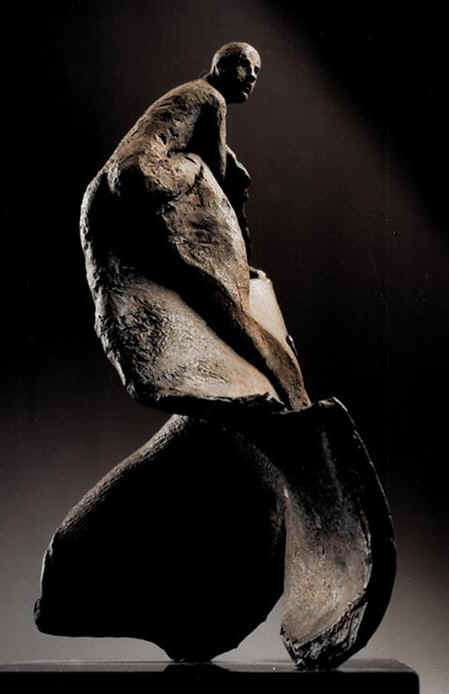
The mesmerizing sculptures of
Belgian artist Hanneke Beaumont marry the classical
values of the
human body as artistic expression with the principles of
20th century abstraction. Her androgynous, quietly
powerful figures, presented in terra cotta and bronze
invite the viewer to contemplate them as they contemplate
us. There is in Beaumont's world a unique tension between
feminine and masculine, nature and culture, modernity and
classicism that makes her sculptures appear at once
timeless and contemporary. Her figures - pensive, draped
in undentifiable clothing - sit or stand on foundations
that depict no age, speaking to us in the universal
language of the human condition.
Most of her works are untitled, in
keeping with the artist's desire not to project ideas but
to allow the viewer to form his or her own
interpretations. Over the past 15 years Beaumont has
increasingly been regarded as one of the world's most
compelling sculptors.
